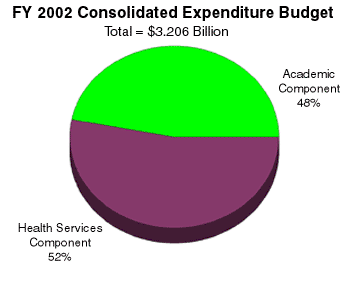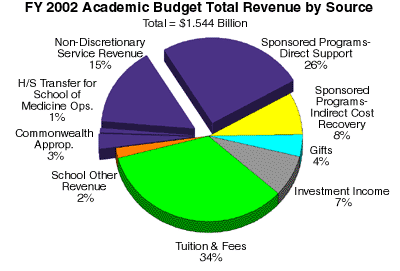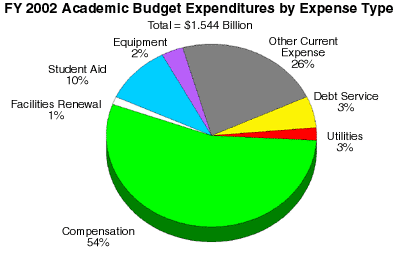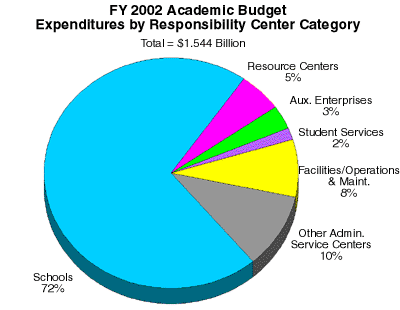|
|
Fiscal
Year 2002 Budget: Report to University Council
The annual
presentation of the FY 2002 budget (July 1, 2001 through June
30, 2002) was made at the March 27 Council meeting. It included
expenditure and revenue perspectives as well as a look at the
indirect cost recovery rate and sponsored project activity. Also
discussed was the endowment as compared to peer institutions and
changes in undergraduate financial aid.
The
text, charts and pies
are from the slide presentation.
Components
of the Consolidated University Budget

FY
2002 Budget Key Points
-
Total
University operating budget of $3.206 billion.
-
Academic
Budget of $1.544 billion.
-
Competitive
increase in undergraduate charges:
--5.8%
increase in Tuition & General Fee
--2.0% increase in Residence Fees
--2.0% increase in Dining Fees
--4.9% increase in Total Charges, versus 3.4% in FY 2001
Note:
See
Almanac March 26, 2002 for the FY 2003 undergraduate
student charges.
Penn's
Financial Planning Approach
-
The
University engages in strategic long-term financial planning.
-
New
programs, priorities and initiatives are discussed and planned
long before they are included in the annual University operating
budget.
-
Consultation
occurs through the Academic Planning & Budget Committee
and in other forums.

How the University's
Budget Supports Goals and Priorities
-
Provost
and Deans work together to develop School budgets that maximize
level of resources available for investment in strategic goals
and priorities.
-
Executive
Vice President and Vice Presidents work together to develop
Central Service Center budgets that maximize level of resources
available for investment in strategic goals and priorities.
-
Limited
central resources--e.g., Subvention, Research Facilities funding,
Facilities Renewal Program funding--are directed wherever possible
towards investments in the Schools that support their most important
goals and priorities.

Growth in
the University's Revenue Sources
Will Be Constrained in FY 2003 and Subsequent Years
-
The
federal ICR (grant overhead) rate is likely to decline in the
coming years, limiting the growth in grant ICR income.
--Rate
has fallen from 65% in FY 1991 to 58.5% in the current fiscal
year.
--Current
rate of 58.5% is guaranteed only through FY 2004.
-
The
Governor is proposing a 7.2% decrease in the University's Commonwealth
Appropriation for next year.
-
Penn's
spending rule provides for only a 0.3% increase in spendable
investment income for FY 2003, in contrast to double-digit growth
in each of the past three years.
-
Most
University business services either break even or generate narrow
margins in sales and service income after meeting all operational
and programmatic requirements.

FY 2002 Academic
Budget Sponsored
Program Indirect Cost Recovery
|
FY
2000 Actual
|
FY
2001 Actual
|
FY
2002 Budget
|
FY
2002 Projection
|
|
Income
($000)
|
115,445
|
125,872
|
128,741
|
138,500
|
|
Federal
ICR Rate
|
58.5%
|
58.5%
|
58.5%
|
58.5%
|
-
Total
direct and indirect Sponsored Program revenue represents approximately
34% of the FY 2002 Academic Revenue Budget.
-
The
School of Medicine accounts for about 64% of Sponsored Program
dollars awarded to the University.
-
According
to data from the University’s most recently submitted Facilities
and Administration Rate Proposal, Penn’s total ICR is nearly
$40 million less than the actual overhead required to support
our annual research effort.


Peer
Institution Endowment/Student
Among Top 20 Endowments as of June 30, 2001
|
Institution
|
Assets
($Billions)
|
($/Student)*
|
|
Princeton
University
|
8.36
|
1,291,098
|
|
Yale
University
|
10.70
|
972,816
|
|
Harvard
University
|
17.95
|
888,729
|
|
M.I.T.
|
6.13
|
620,964
|
|
Stanford
University
|
8.25
|
563,841
|
|
Dartmouth
College
|
2.41
|
455,286
|
|
Washington
University
|
3.95
|
364,732
|
|
Chicago,
University of
|
3.52
|
317,321
|
|
Cornell
University
|
3.15
|
249,654
|
|
Columbia
University
|
4.29
|
240,237
|
|
Northwestern
University
|
3.26
|
220,307
|
|
PENN
|
3.38
|
177,094
|
*Based on FTE
students as of Fall 2000

FY
2002 Financial Aid Budget General Operating,
Gift, and Investment Income ($000)
|
FY
2001 Actual
|
FY
2002 Budget
|
%
Change
|
|
Undergraduate
Student Aid
|
54,247
|
59,500
|
9.7%
|
|
Graduate
Student Aid
|
61,950
|
67,350
|
8.7%
|
|
Total
Student Aid
|
116,197
|
126,850
|
9.2%
|
-
Fundraising
for financial aid endowment remains a top priority
-
Undergraduate
need-blind policy is a competitive necessity
-
Penn
remains significantly under-endowed relative to peers
-
Effective
2002, Student Health Insurance premiums for eligible graduate
students are reflected in the Graduate Student Aid figure
Note: Figures
exclude Sponsored Program Funds.
Illustrative
Needs for Academic Investment
Continuing major
investment is needed to maintain the quality of Penn’s academic
and co-curricular programs. Some examples:
|
|
Estimated 5-Year Investment Required
|
|
Additional
funding--Faculty recruitment/retention
|
$
25 Million
|
|
Undergraduate
housing and dining
|
$
200 Million
|
|
Undergraduate
and graduate financial aid
|
$
100 Million
|
|
Continued
investments in information technology (Research System, Student
System, Advancement System, HR System)
|
$
30 Million
|
|
Pottruck
Health & Fitness Center building
|
$
24 Million
|
|
Life
Sciences building (Phase I)
|
$
57 Million
|
|
SVM
new research building
|
$
48 Million
|
|
Whitaker
Bioengineering building/program
|
$
57 Million
|
|
Bennett
Hall renovation
|
$
13 Million
|
|
Huntsman
Hall building
|
$
140 Million
|
|
Facilities
Renewal (additional funding–next 5 yrs.)
|
$
25 Million
|
|
Increased
property/casualty insurance costs
|
$
10 Million
|

How Penn
is Achieving its Goals in Light of Serious Fiscal Constraints
-
Efficiency
--Both in
Central Service Centers and in administration of Schools
-
Development
--Ambitious,
successful, focused fundraising in support of strategic priorities
and goals
-
University/Private
Sector Partnerships
--Getting
others to spend their money to do things Penn needs so that
our own resources can be spent on core academic priorities
Almanac, Vol. 48, No. 29, April 9, 2002
|
ISSUE
HIGHLIGHTS:
Tuesday,
April 9, 2002
Volume 48 Number 29
www.upenn.edu/almanac/
| It's once
again time to recognize excellence in teaching at Penn, with
the Lindback and Provost's Awards. And
the recipients are…. |
|
A
political science professor is appointed to a
term chair.
|
| Four of
Penn's schools make the grade on the
top ten list of U.S. News graduate schools. |
| Observations
on the experimental SAS
Pilot Curriculum, including insights, accomplishments and
challenges. |
| An graphic
report on the University's
FY 2002 Budget, as reported to Council. |
| Research
Roundup: a few of the many Penn projects and studies shed
light on interventions, risk-reductions, treatment strategies
and post-traumatic stress. |
|









